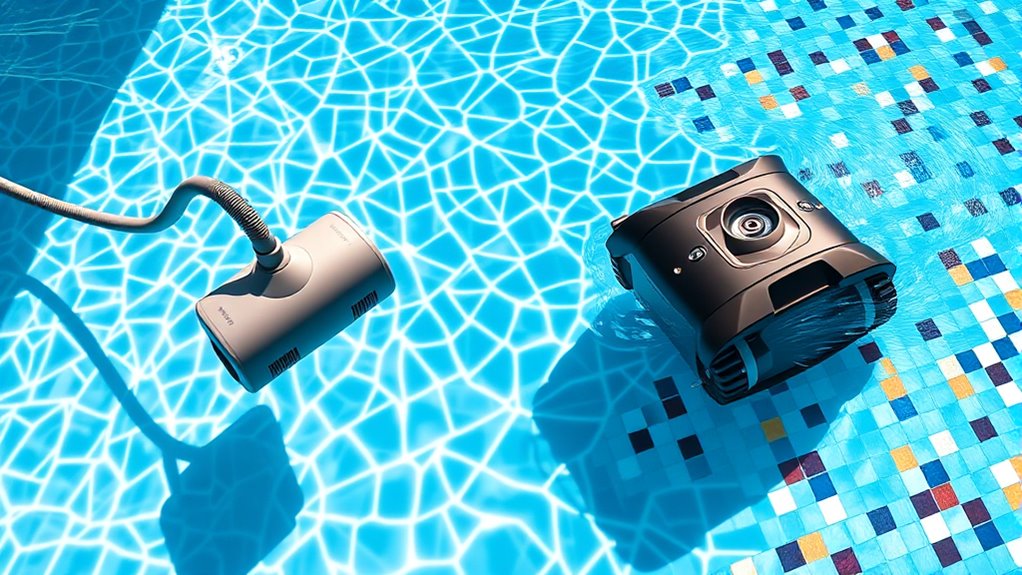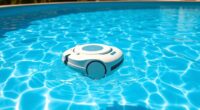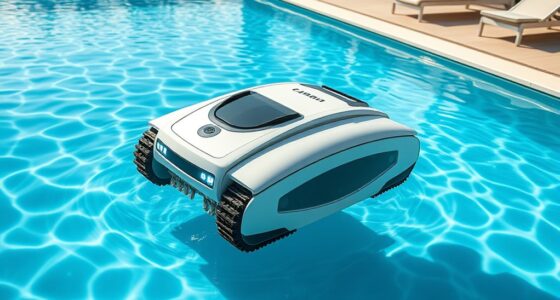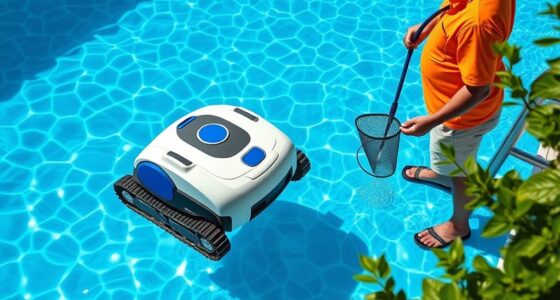Suction pool cleaners are affordable and simple to operate, connecting directly to your pool’s filtration system for basic debris removal, but they may require more manual guidance and maintenance over time. Robotic pool cleaners, though pricier upfront, provide automated, thorough cleaning with advanced navigation and filtration, making them easier to maintain and more efficient. To discover which option suits your pool, explore the detailed differences and features that follow.
Key Takeaways
- Robotic cleaners offer independent operation with advanced navigation, while suction cleaners rely on pool filtration system suction.
- Suction cleaners are generally more affordable upfront but may have higher maintenance costs over time.
- Robotic cleaners provide thorough, systematic cleaning with easier troubleshooting and less manual intervention.
- Suction cleaners are simpler to set up and ideal for routine, basic debris removal; robotic models excel in comprehensive cleaning.
- Durability varies; robotic cleaners often have sealed electronics and corrosion-resistant parts, lasting longer than some suction models.
Overview of Suction Pool Cleaners
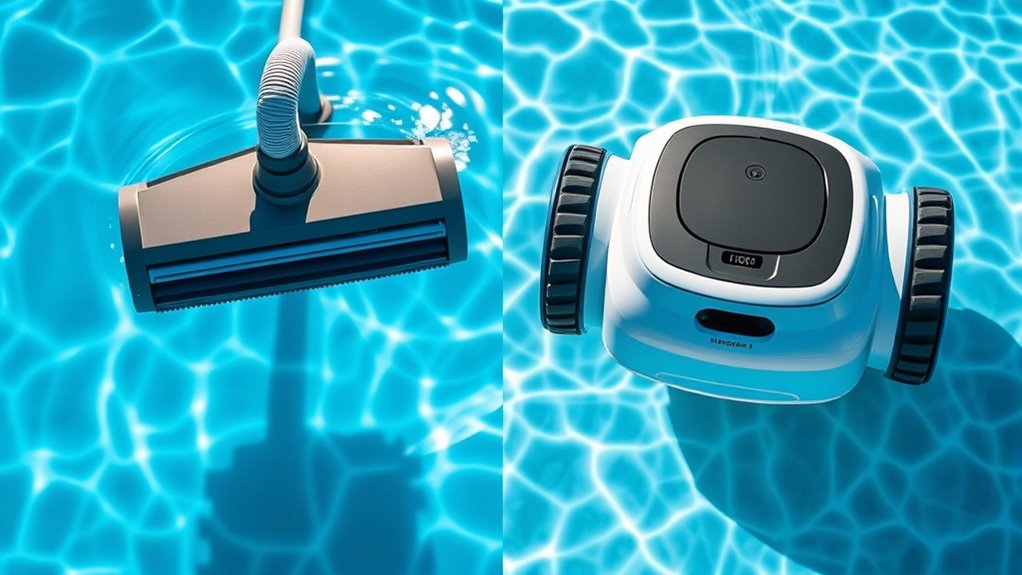
Suction pool cleaners are a popular choice for maintaining clean pools because they connect directly to your pool’s existing filtration system. They work by using the suction created by your pump to pull debris from the pool floor and walls. When selecting one, consider your pool size, as larger pools may require more powerful or larger-capacity models to clean efficiently. User preferences also matter; some prefer lightweight, easy-to-handle cleaners, while others need models with advanced features like adjustable settings or extended hoses. Suction cleaners are generally simple to operate and maintain, making them ideal for routine cleaning. They’re perfect if you want a straightforward, cost-effective solution that can be customized based on your pool size and cleaning needs.
Overview of Robotic Pool Cleaners
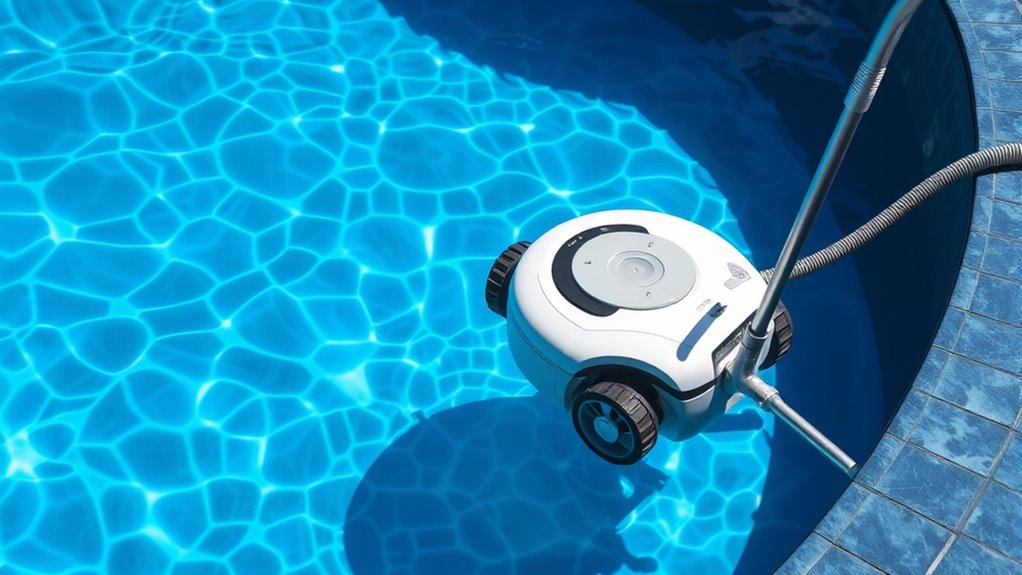
Robotic pool cleaners have gained popularity because they offer autonomous, efficient cleaning without relying on your pool’s filtration system. These devices operate independently, maneuvering your pool to scrub surfaces, walls, and floors. Many models are designed with energy efficiency in mind, consuming less power than traditional cleaners. Some robotic cleaners even harness solar power, reducing electricity costs and environmental impact. Their advanced sensors enable precise movement, ensuring thorough coverage of the entire pool. With programmable schedules and smart navigation, you can set them to clean automatically, saving you time and effort. Additionally, emerging sound healing science research suggests that integrating sound therapy with cleaning routines might promote relaxation during pool maintenance. Incorporating eco-friendly features enhances their appeal to environmentally conscious consumers. Overall, robotic pool cleaners combine technological innovation with eco-friendly features, making them a convenient and sustainable choice for maintaining a sparkling clean pool.
Furthermore, advanced navigation systems ensure comprehensive coverage, minimizing missed spots and reducing cleaning time.
Operating Mechanisms and Technology
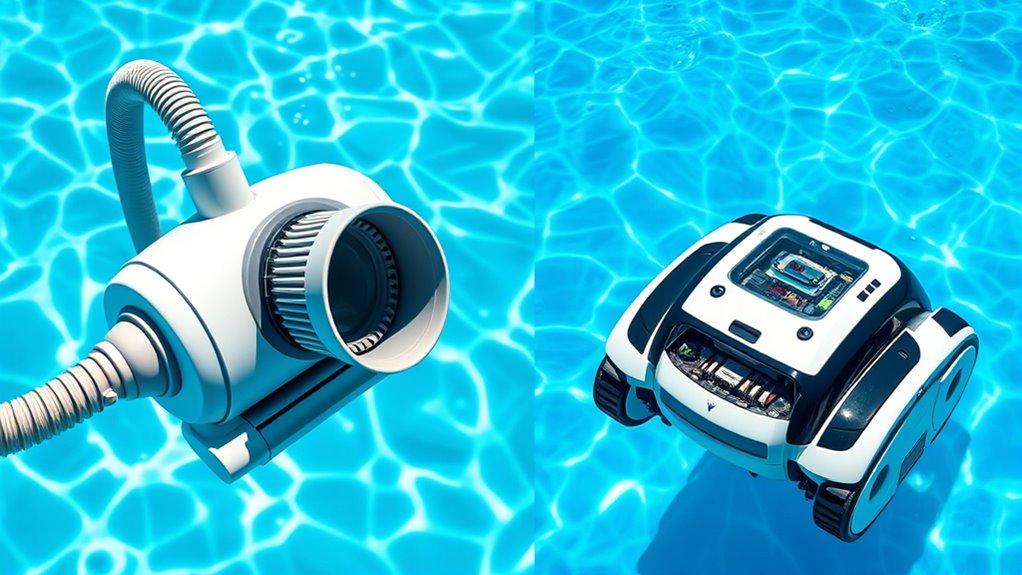
You’ll want to understand how suction power and filters affect cleaning efficiency, as well as how navigation and programming enable the cleaner to cover your pool thoroughly. Different models use varying mechanisms to pick up debris and move around, impacting performance and convenience. Let’s explore how these operating features compare between suction and robotic pool cleaners. Additionally, Volkswagen Tuning techniques, such as engine optimization and suspension upgrades, demonstrate how precise adjustments can significantly enhance vehicle performance and handling, much like how selecting the right cleaning mechanism can improve your pool maintenance. Understanding the operating mechanisms of each type can help you make an informed choice that best suits your pool cleaning needs. For example, filter types play a crucial role in debris capture and maintenance requirements, influencing overall cleaning effectiveness. Moreover, the filter systems used in robotic cleaners are often designed to be easily washable and replaceable, simplifying maintenance tasks. Incorporating advanced sensors in robotic cleaners enables smarter navigation and obstacle avoidance, leading to more thorough cleaning cycles.
Suction Power and Filters
While both suction pool cleaners and robotic models rely on powerful motors to operate, their suction power and filtering mechanisms differ markedly. Suction pool cleaners typically boast higher suction strength, enabling them to pull in larger debris efficiently. Their filter capacity varies, influencing how much dirt they can hold before needing cleaning. Robotic cleaners, on the other hand, often feature advanced filtration systems with multiple filter types, capturing fine particles and bacteria. To understand their effectiveness, consider these points: 1. Suction strength determines how well debris is lifted from the pool floor. 2. Filter capacity impacts how often you need to empty the debris container. 3. Some models incorporate multi-stage filters for enhanced cleaning performance. Additionally, brand reputation and certifications can influence the reliability and effectiveness of your pool cleaner. Choosing the right cleaner depends on your pool’s debris load and desired filtration level. Proper maintenance and understanding of operating mechanisms can significantly extend the lifespan and efficiency of your pool cleaning system.
Navigation and Programming
Navigation and programming are crucial factors that determine how effectively a pool cleaner covers the entire surface area. Suction pool cleaners often rely on manual controls, requiring you to guide or reposition them, which can be time-consuming. In contrast, robotic pool cleaners typically feature advanced navigation systems, such as sensors and algorithms, enabling them to map your pool and clean methodically. Many robotic models also offer remote operation, allowing you to start, stop, or pause cleaning sessions from a distance. This automation guarantees thorough coverage without your direct involvement, saving you effort. Overall, robotic cleaners excel in navigation and programming, providing smarter, more efficient cleaning compared to suction models that depend heavily on manual controls. Navigation systems play a vital role in determining the efficiency of robotic pool cleaners, as they utilize sophisticated sensor technology to optimize coverage and adaptive algorithms to adjust to different pool shapes and obstacles. Additionally, programming capabilities allow these robots to customize cleaning patterns and schedules for maximum convenience.
Cost and Budget Considerations
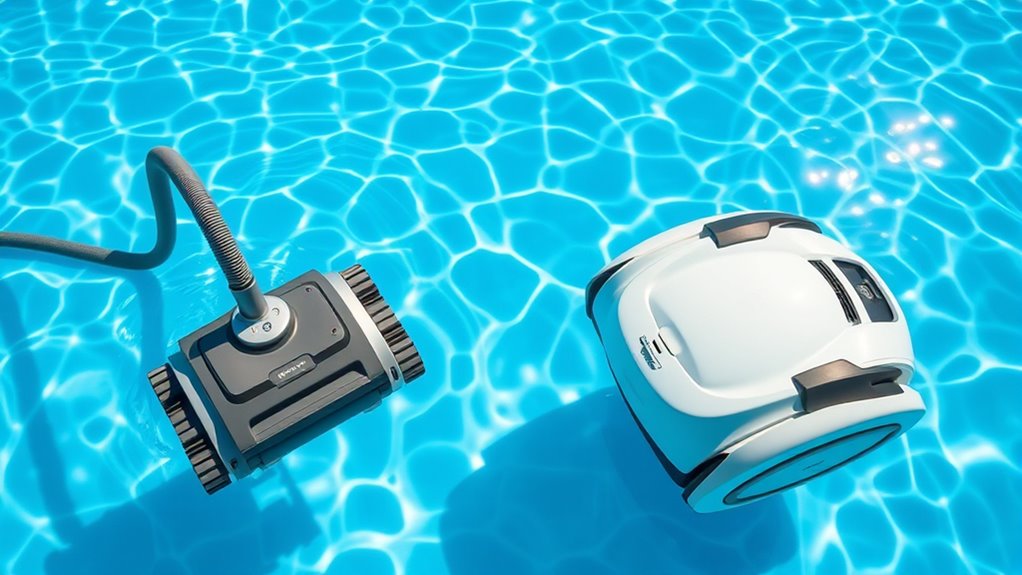
Cost is a key factor when choosing between suction pool cleaners and robotic pool cleaners, as their prices can vary markedly. Robotic cleaners tend to have higher upfront costs but often include longer-lasting parts and advanced features. Suction cleaners are typically more affordable but may require more maintenance over time. When evaluating options, consider warranty options, as longer warranties can save you money on repairs. Also, check the brand reputation; established brands often provide better customer support and reliability, which can justify a higher price. Additionally, breakdown of features can help determine which cleaner offers the best value for your specific needs. Understanding cost considerations and local resources can also influence your decision, especially if maintenance or repairs are needed in a new area. Moreover, considering exfoliation benefits related to skin care can influence your overall approach to choosing the right pool cleaning technology for your needs. Being aware of the maintenance requirements associated with each type can further help you choose a system that aligns with your schedule and budget.
Ease of Use and Maintenance
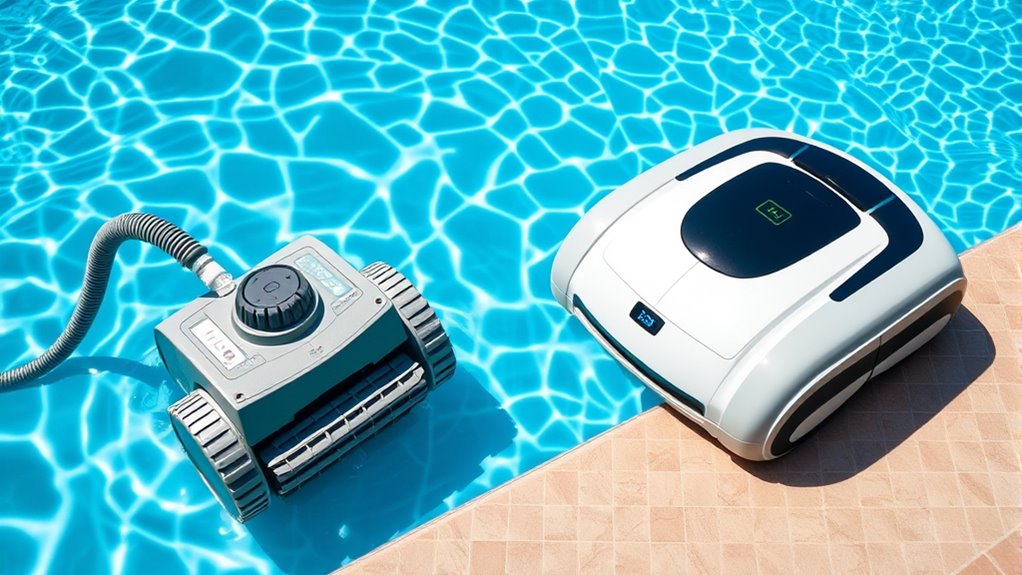
When it comes to ease of use and maintenance, you’ll want to contemplate how simple it is to set up and install each type of cleaner. Keeping them clean and performing regular upkeep can vary, affecting how much time and effort you’ll spend. Plus, troubleshooting and repairs can be straightforward or complicated, depending on the model you choose.
Setup and Installation
Setting up a suction pool cleaner or a robotic pool cleaner is generally straightforward, but they differ in how much effort each requires. With a suction model, you’ll need to connect it to your pool’s skimmer or dedicated suction line, ensuring the hose length matches your pool size. Robotic cleaners often require simple placement in the pool and connection to a power source, with minimal setup. To optimize performance, consider these factors:
- Adjust for pool size to ensure proper coverage and suction.
- Balance water chemistry to prevent debris buildup and maintain cleaner efficiency.
- Verify filtration systems are clean to support effective cleaning.
Both types are designed for ease of use, but robotic cleaners tend to require less manual setup, especially in larger pools.
Cleaning and Upkeep
Robotic pool cleaners generally offer a simpler maintenance routine compared to suction models. They usually require less frequent bag or filter cleaning, making upkeep more straightforward. With their advanced filters, you can often rinse out debris quickly, saving time and effort. When considering pool size, robotic cleaners adapt easily to larger pools, maintaining consistent cleaning without extra hassle. They also help preserve your pool’s aesthetic appeal by thoroughly cleaning surfaces and reducing algae buildup. Suction cleaners, on the other hand, may need more frequent filter changes and adjustments, especially in bigger pools. Overall, robotic cleaners are designed for ease of use, so you spend less time on upkeep and more time enjoying a spotless pool.
Troubleshooting and Repairs
Troubleshooting and repairing robotic pool cleaners are generally easier than with suction models, thanks to their user-friendly designs. You can quickly address common issues related to pool size or debris type with minimal hassle. For example:
- Clogged filters: Debris like leaves or small twigs can block the filter, especially in larger pools or with heavy debris. Regular cleaning keeps the robot running smoothly.
- Navigation errors: Larger pools may cause navigation issues; resetting or recalibrating the robot often fixes this.
- Power or connectivity problems: Electrical or Wi-Fi issues can be resolved by checking connections or replacing faulty parts, which is straightforward due to accessible design features.
Cleaning Efficiency and Performance
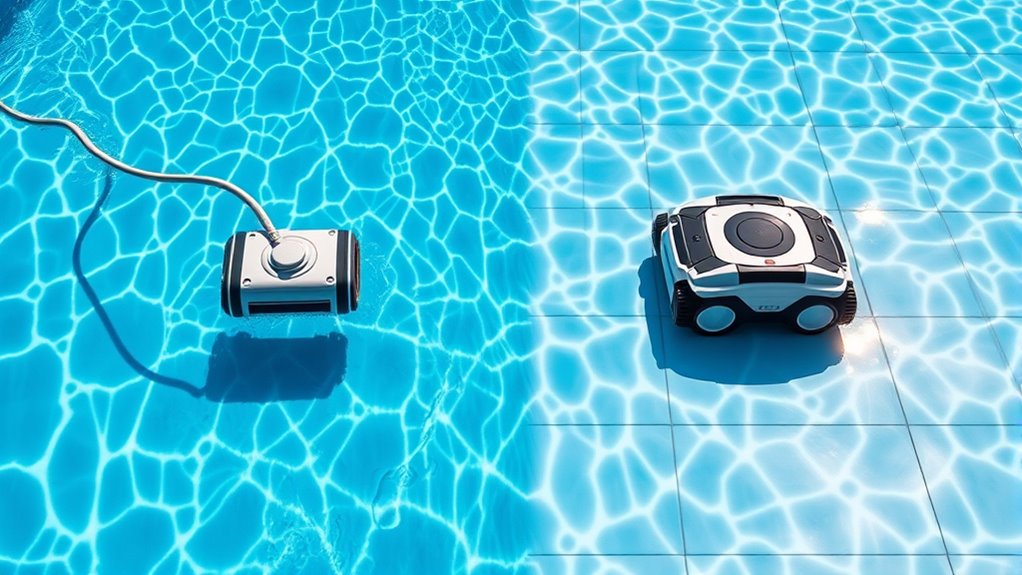
When it comes to cleaning efficiency and performance, suction pool cleaners and robotic pool cleaners each have their strengths. Suction cleaners rely on simple cleaning algorithms that follow basic paths, which can sometimes miss spots or overlap. They generally perform well on straightforward debris but might struggle with complex pool shapes. Robotic cleaners, however, use advanced cleaning algorithms to map out your pool, ensuring thorough coverage. They tend to be more efficient overall, often cleaning more effectively in less time. While robotic cleaners may consume more energy due to their motors and electronics, many models are designed with energy-efficient features. Overall, robotic cleaners deliver superior performance, but your choice depends on balancing cleaning thoroughness with energy consumption.
Durability and Longevity
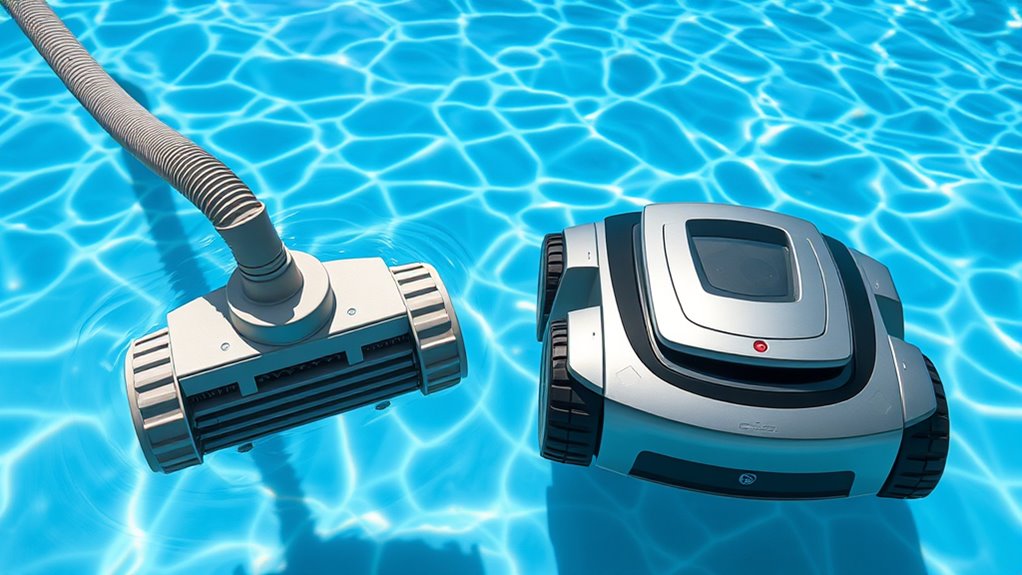
Durability and longevity are essential factors to contemplate when choosing a pool cleaner, as they determine how well the device withstands regular use and exposure to pool conditions. To guarantee your investment lasts, consider these key aspects:
Durability ensures your pool cleaner withstands regular use and harsh pool conditions for lasting performance.
- Material strength: Look for cleaners made with robust materials that resist cracking or breaking under stress.
- Corrosion resistance: Ensure the device’s components are resistant to pool chemicals and water, preventing rust and degradation.
- Build quality: Opt for models with sturdy construction and secure fittings to handle daily wear and tear.
Robotic cleaners often excel here, with sealed electronics and corrosion-resistant casings. Suction cleaners, while simpler, can be less resilient if made from lower-quality materials. Prioritize durability to maximize your cleaner’s lifespan and performance.
Which Type Is Best for Your Pool?
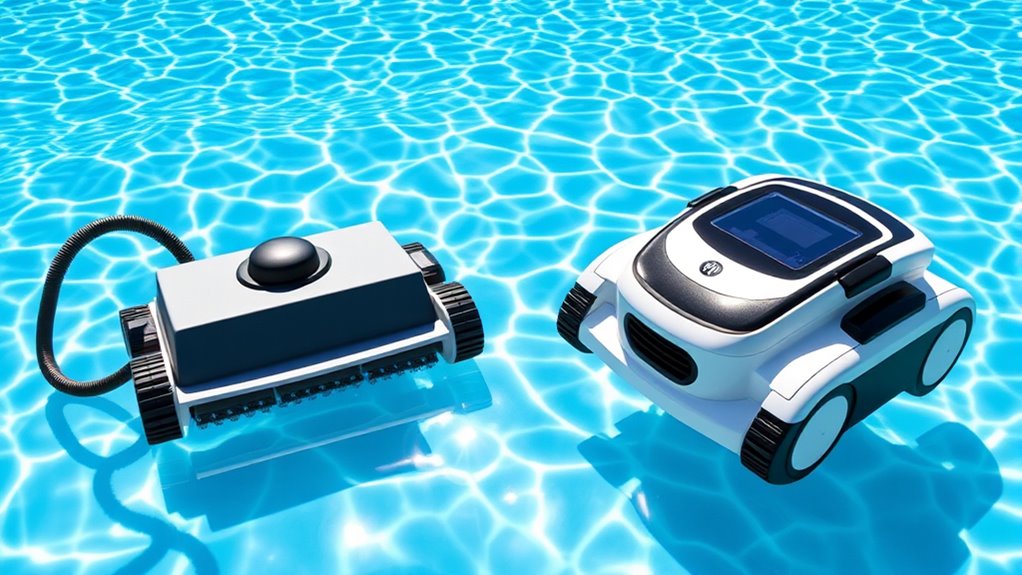
Determining which pool cleaner is best for your needs depends on several factors, including pool size, shape, and your cleaning preferences. If you prioritize pool safety, robotic cleaners offer thorough coverage and reduce the risk of damage caused by manual cleaning. They also consume less energy, making them more cost-efficient and environmentally friendly. Conversely, suction pool cleaners are effective for larger pools and are typically simpler to operate, though they might require more energy during extended use. Consider how much you value convenience versus thoroughness; robotic cleaners often provide automated, detailed cleaning but at a higher upfront cost. Ultimately, your choice hinges on balancing pool safety, energy consumption, and your specific cleaning needs to select the most suitable option.
Frequently Asked Questions
How Do Suction and Robotic Pool Cleaners Handle Different Pool Shapes?
When it comes to managing different pool shapes, you’ll find that suction and robotic cleaners vary in cleaning efficiency. Suction cleaners work well on simple, straight-edged pools and are affected by pool material, which can impact suction power. Robotic cleaners adapt better to complex shapes, maneuvering around obstacles with ease, ensuring thorough cleaning regardless of pool design. Your choice depends on your pool’s shape and material, aiming for ideal cleaning results.
Are Robotic Pool Cleaners Suitable for Above-Ground Pools?
Robotic pool cleaners are suitable for above-ground pools, especially if you consider your pool size and cleaning speed. They’re designed to handle various shapes and sizes, making them a good choice for above-ground setups. You just need to pick one with the right capacity and cleaning efficiency. Their autonomous operation means you get thorough cleaning without manual effort, keeping your pool spotless and ready for use.
Can Suction and Robotic Cleaners Operate While the Pool Is in Use?
Did you know that over 60% of pool owners prefer cleaners that work while swimming? Yes, suction and robotic cleaners can operate during pool use, but it’s not always ideal. Pool chemicals can interfere with their sensors, and running them during use lowers energy efficiency. For the best results, turn off cleaners during swim times, ensuring safety and proper cleaning without affecting chemical balance or energy consumption.
What Safety Features Are Included in Modern Suction and Robotic Cleaners?
Modern pool cleaners come with safety features like safety sensors that detect obstructions or entrapment, preventing accidents. They also include automatic shutoff systems, which turn the device off if issues arise or when cleaning is complete. These safety features guarantee you can operate your cleaner confidently, knowing it will pause or stop if something’s wrong, reducing risks and keeping your pool area safe while the cleaner works efficiently.
Do These Cleaners Require Professional Installation or Setup?
Many believe you need professional help to set up pool cleaners, but that’s not always true. Most modern suction and robotic cleaners are designed for easy setup, with clear instructions and minimal tools. Their installation requirements are straightforward, often just plugging in and connecting to your pool’s system. While some models may have more complex setup processes, generally, you can handle the setup yourself without professional assistance, saving time and money.
Conclusion
Choosing between suction and robotic pool cleaners is like selecting the perfect dance partner—you want one that moves smoothly and keeps your pool shining effortlessly. While both have their charm, finding the right fit depends on your pool’s size, your budget, and how much time you want to spend on maintenance. Whichever you pick, a little care will make sure your pool stays inviting, turning every swim into a invigorating escape you’ll look forward to.
